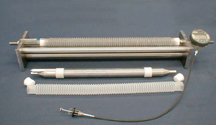
Cement Paste and Mortar
ASTM International C09 on Concrete and Concrete Aggregates has recently approved a new standard, C1698, Test Method for Autogenous Strain of Cement Paste and Mortar. This document was developed by Subcommittee C09.68 on Volume Change.Autogenous shrinkage can be a significant cause of early age cracking in low water-to-cementitious-materials ratio (w/cm) high performance concrete. This cracking can result in serious problems with strength, durability and aesthetics. Autogenous shrinkage can be significant in the first 24 hours after placing concrete and is not detected by the commonly used ASTM C157/C157M, Test Method for Length Change of Hardened Hydraulic-Cement Mortar and Concrete.Quantifying the autogenous shrinkage of different concrete mixtures is a prerequisite to calculating and limiting cracking risk. Autogenous strain is the self-created bulk strain of cement paste, mortar or concrete during hardening at constant temperature under sealed conditions. According to Fred Goodwin, chairman, C09.68, the primary users of C1698 are material producers and specifiers of higher strength concretes. "Additionally, the standard is applicable to the development of internal curing methods for concrete and the evaluation of shrinkage-reducing admixtures," says Goodwin.Interested parties are welcome to participate in the ongoing refinement of the standard. The subcommittee is currently working on a round robin study to develop the interlaboratory reproducibility statement and to extend the application of the method to concretes of coarser aggregate sizes than currently allowed.To purchase ASTM International standards, visit www.astm.org and search by the standard designation number, or contact ASTM Customer Relations (phone: 610-832-9585).
CONTACT Technical Information: Fred Goodwin, FICRI • Beachwood, Ohio • Phone: 216-839-7009 E-mail: fred.goodwin@basf.com O ASTM Staff: Scott Orthey • Phone: 610-832-9730 • E-mail: sorthey@astm.org O Upcoming Meeting: June 6-9 • June Committee Week • St. Louis, Mo.
 SN Home
SN Home Archive
Archive Advertisers
Advertisers Masthead
Masthead RateCard
RateCard Subscribe
Subscribe Email Editor
Email Editor